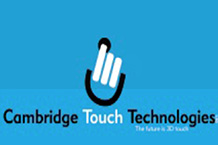|
We are delighted to announce that the University of Cambridge Enterprise Fund III has closed an investment in CTT, a spin-out from...
|
|
|||||
 |
|
|||||
|
|||||
|
Dear , Cambridge Touch Technologies (CTT) is a Cambridge start-up with close ties to the Centre for Advanced Photonics and Engineering (CAPE) at the University of Cambridge. The technology has been developed in collaboration with the laboratory of Professor Arokia Nathan with whom the company has an ongoing relationship. The Technology CTT enables mobile devices to sense location and force of a multi-touch input. It directly integrates touch force-sensing into conventional projected-capacitive (p-cap) multi-touch sensors. Using a special layer built into the p-cap sensor architecture, both the location and force are detected by variations in capacitive and voltage responses caused by either a conductive or non-conductive touch. The key innovation is the conversion of a single combined signal from the force touch panel into both accurate touch location and force information using CTT’s proprietary analog and signal processing technology. No additional sensors, pins or connectors are required. Compared to first generation 3D Touch technology that has recently hit the market in smartphones, CTT’s next-generation technology offers several compelling advantages such as per finger sensing, scalability to any device size, better battery life, and lower cost. This disruptive technology can be manufactured via conventional touch panel processes, thus leading to high adoption potential by the established global touch panel supply chain. The Business Model The company is building a strong IP portfolio and has multiple applications filed describing the architecture implementation, single signal capture and noise reduction, and low power driving. A patent review by Cambridge-based IP firm, Venner-Shipley LLC, indicated there were no prior patents or filings identified. Generating a single signal then separating it appears novel and a key advantage is simplicity versus prior art. The business model is therefore to market directly to OEMs to create demand and provide integration services to optimise CTT 3D force touch to their specific device. The company will also license touch film and IC technologies to touch panel and IC component manufacturers. There are already a number of commercial discussions with large MNCs. The current competitive position appears favourable for CTT. There have been multiple attempts at Force Touch since 1993 by companies such as IBM, Vissumo, Peratech, F-Origin and Blackberry. All have failed. More recently, Apple has led the field with the introduction of their 3D Touch, but their current approach is complex and expensive, with market research firms estimating a cost of $8-$10 per iPhone. CTT estimate their technology will cost $1.00 or less per device through a license fee as well as conferring significant power consumption gains and other benefits. CTT hope to have their first design win in the first half of 2017 which should lead to customer shipments in the second half of 2017. Management Professor Arokia Nathan, CTO, Professor Cambridge University, circuit design & signal processing expert, >50 patents & 100+ publications, founder and former CTO IGNIS Innovation Corbin Church, CEO, Former VP of Biz Dev at IGNIS Innovation, with extensive knowledge and network in the touch and display industries. Dr SB Cha,Director, CEO Kinestral Technologies, former SVP Business Development CDT, with alliance, JV, IPO & trade sale experience. The Opportunity The current Seed funding round is expected to last the company around 12 months and allow CTT to produce a prototype. The company then projects a Series A funding round in 2016 of around £5m will be required to fund engineering sample development, engage with OEMs, and secure a first design win and market entry in 2017. This illustrates the capital efficient licensing and service business model. CTT estimate that the potential market exceeds 2 billion units a year and there is significant activity in this market as the large mobile device manufacturers seek to position themselves in response to Apple’s current leadership in this field. If CTT can develop commercial traction rapidly the opportunity is significant and a likely exit is through a trade buyer probably at a point where a major OEM signs a significant deal. |
||
|
|||||
|
|||||
|
|||||
|
|||||
|
||
|
|||||





